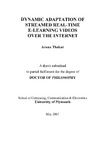Dynamic adaptation of streamed real-time E-learning videos over the internet
| dc.contributor.author | Thakur, Aruna | |
| dc.contributor.other | School of Engineering, Computing and Mathematics | en_US |
| dc.date.accessioned | 2011-05-12T13:30:35Z | |
| dc.date.available | 2011-05-12T13:30:35Z | |
| dc.date.issued | 2007 | |
| dc.identifier | Not available | en_US |
| dc.identifier.uri | http://hdl.handle.net/10026.1/430 | |
| dc.description.abstract |
Even though the e-learning is becoming increasingly popular in the academic environment, the quality of synchronous e-learning video is still substandard and significant work needs to be done to improve it. The improvements have to be brought about taking into considerations both: the network requirements and the psycho- physical aspects of the human visual system. One of the problems of the synchronous e-learning video is that the head-and-shoulder video of the instructor is mostly transmitted. This video presentation can be made more interesting by transmitting shots from different angles and zooms. Unfortunately, the transmission of such multi-shot videos will increase packet delay, jitter and other artifacts caused by frequent changes of the scenes. To some extent these problems may be reduced by controlled reduction of the quality of video so as to minimise uncontrolled corruption of the stream. Hence, there is a need for controlled streaming of a multi-shot e-learning video in response to the changing availability of the bandwidth, while utilising the available bandwidth to the maximum. The quality of transmitted video can be improved by removing the redundant background data and utilising the available bandwidth for sending high-resolution foreground information. While a number of schemes exist to identify and remove the background from the foreground, very few studies exist on the identification and separation of the two based on the understanding of the human visual system. Research has been carried out to define foreground and background in the context of e-learning video on the basis of human psychology. The results have been utilised to propose methods for improving the transmission of e-learning videos. In order to transmit the video sequence efficiently this research proposes the use of Feed- Forward Controllers that dynamically characterise the ongoing scene and adjust the streaming of video based on the availability of the bandwidth. In order to satisfy a number of receivers connected by varied bandwidth links in a heterogeneous environment, the use of Multi-Layer Feed-Forward Controller has been researched. This controller dynamically characterises the complexity (number of Macroblocks per frame) of the ongoing video sequence and combines it with the knowledge of availability of the bandwidth to various receivers to divide the video sequence into layers in an optimal way before transmitting it into network. The Single-layer Feed-Forward Controller inputs the complexity (Spatial Information and Temporal Information) of the on-going video sequence along with the availability of bandwidth to a receiver and adjusts the resolution and frame rate of individual scenes to transmit the sequence optimised to give the most acceptable perceptual quality within the bandwidth constraints. The performance of the Feed-Forward Controllers have been evaluated under simulated conditions and have been found to effectively regulate the streaming of real-time e-learning videos in order to provide perceptually improved video quality within the constraints of the available bandwidth. | en_US |
| dc.language.iso | en | en_US |
| dc.publisher | University of Plymouth | en_US |
| dc.title | Dynamic adaptation of streamed real-time E-learning videos over the internet | en_US |
| dc.type | Thesis | |
| dc.identifier.doi | http://dx.doi.org/10.24382/4722 | |
| dc.identifier.doi | http://dx.doi.org/10.24382/4722 |
Files in this item
This item appears in the following Collection(s)
-
01 Research Theses Main Collection
Research Theses Main


